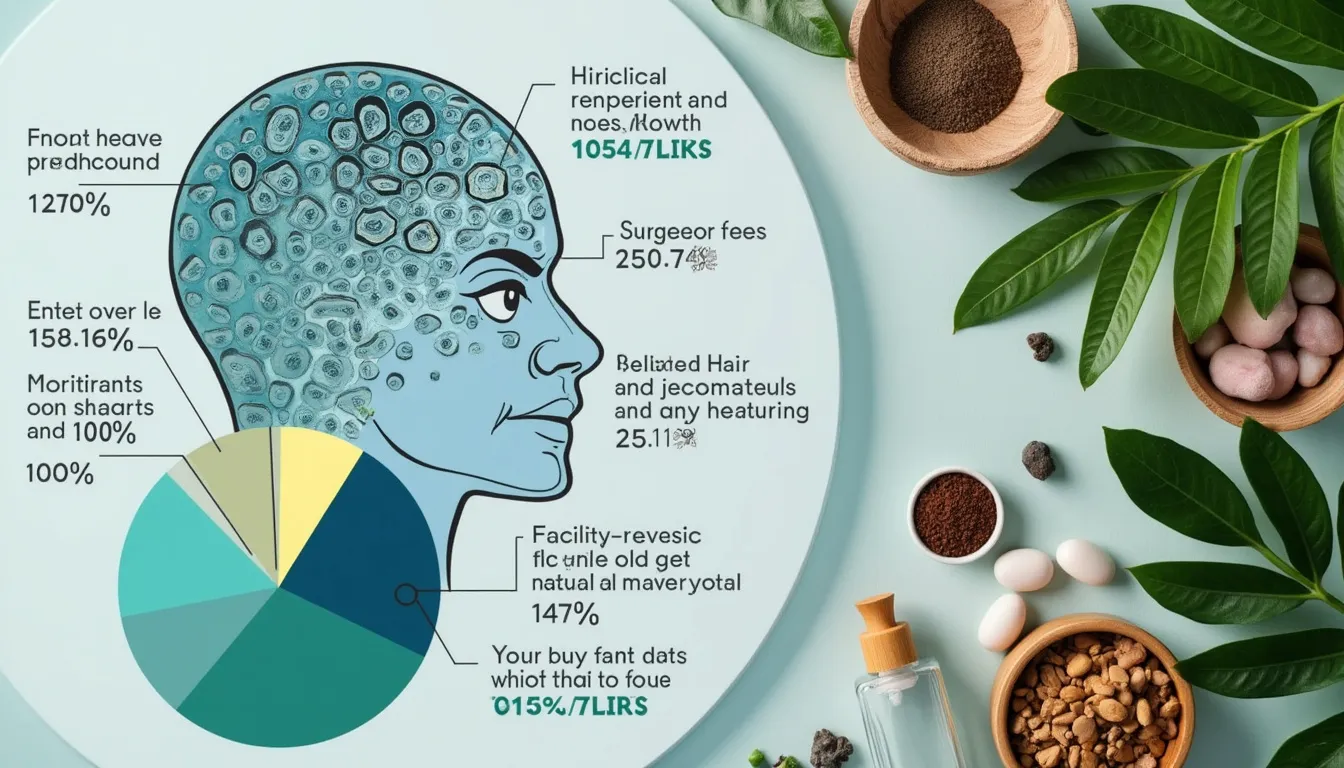Are you considering a hair transplant but feeling overwhelmed by the potential costs? You’re not alone. Many people seeking a solution to hair loss find themselves navigating the complex world of hair restoration, with price being a significant factor in their decision-making process. Understanding hair transplant cost is crucial for anyone looking to invest in fuller, natural-looking hair. In this comprehensive guide, we’ll dive deep into the various factors that influence the price of hair transplant procedures, provide you with a realistic breakdown of what to expect financially, and offer insights on how to maximize the value of your investment. Whether you’re just starting your research or you’re close to making a decision, this article will equip you with the knowledge you need to approach hair transplant costs with confidence. From the type of procedure to the expertise of your chosen surgeon, we’ll cover all the elements that contribute to the final price tag of your hair restoration journey. So, let’s unravel the mysteries of hair transplant pricing and help you make an informed decision about your hair restoration options.
Factors Influencing Hair Transplant Cost
When considering a hair transplant, one of the first questions that often comes to mind is, How much will it cost? The truth is, hair transplant cost can vary significantly depending on several key factors. Understanding these elements can help you better estimate the potential investment required for your journey to fuller hair.
Type of Transplant Procedure: FUT vs. FUE
The method used for your hair transplant plays a crucial role in determining the overall cost. There are two primary techniques: Follicular Unit Transplantation (FUT) and Follicular Unit Extraction (FUE).
- FUT (Follicular Unit Transplantation): Also known as the strip method, FUT involves removing a strip of scalp from the donor area, usually the back of the head. This strip is then dissected into individual follicular units for transplantation. FUT is generally less time-consuming and, as a result, often less expensive than FUE.
- FUE (Follicular Unit Extraction): This more modern technique involves extracting individual follicular units directly from the donor area. While FUE is typically more expensive due to its labor-intensive nature, it offers advantages such as minimal scarring and a quicker recovery time.
On average, FUE procedures can cost 10-20% more than FUT. However, the specific price difference can vary depending on the clinic and the extent of the transplant needed.
Number of Grafts Required
The extent of hair loss and the desired density of the transplanted hair significantly impact the cost. Hair transplants are typically priced per graft, with each graft containing 1-4 hair follicles. The number of grafts needed can range from 500 for minor restoration to over 3,000 for more extensive procedures.
Here’s a general breakdown of graft requirements based on the extent of hair loss:
- Minor hair loss: 500-1,500 grafts
- Moderate hair loss: 1,500-3,000 grafts
- Extensive hair loss: 3,000-5,000+ grafts
The price per graft can vary widely, typically ranging from $3 to $8. This means a procedure requiring 2,000 grafts could cost anywhere from $6,000 to $16,000. It’s important to note that many clinics offer package deals or sliding scale pricing, where the cost per graft decreases as the number of grafts increases.
Surgeon’s Expertise and Clinic Reputation
The old adage you get what you pay for often holds true in the world of hair transplants. The expertise of your surgeon and the reputation of the clinic can significantly influence the cost of your procedure.
Highly skilled surgeons with extensive experience and a track record of successful transplants typically command higher fees. These professionals often use state-of-the-art equipment and employ well-trained staff, all of which contribute to higher operational costs reflected in the procedure price.
Renowned clinics, especially those in major metropolitan areas or those known as celebrity hair restoration centers, often charge premium rates. While this doesn’t necessarily mean they provide better results than less expensive options, their reputation and perceived prestige factor into their pricing.
It’s crucial to balance cost considerations with quality and safety. A cheaper procedure might seem attractive initially, but it could lead to subpar results or even complications that may require costly corrective procedures in the future.
Geographic Location
The location of the clinic can have a significant impact on hair transplant cost. Prices can vary dramatically not just between countries, but also between different regions within the same country.
For instance, hair transplants in the United States are generally more expensive than those in countries like Turkey, India, or Thailand, which have become popular destinations for medical tourism. However, even within the U.S., prices can differ substantially between major cities and smaller towns.
Here’s a rough comparison of average hair transplant costs in different locations:
- United States: $4,000 – $15,000+
- United Kingdom: £3,000 – £15,000
- Turkey: $1,500 – $5,000
- India: $500 – $3,000
While traveling abroad for a hair transplant can significantly reduce costs, it’s essential to consider factors such as the quality of care, follow-up treatment, and potential language barriers. Always thoroughly research any clinic, regardless of location, before committing to a procedure.
Additional Factors Affecting Cost
Several other elements can influence the final price of your hair transplant:
- Pre-operative tests: Blood work or scalp biopsies may be required, adding to the overall cost.
- Anesthesia: The type of anesthesia used (local or general) can affect the price.
- Post-operative care: This includes medications, special shampoos, and follow-up appointments.
- Travel expenses: If you’re traveling for the procedure, factor in costs for transportation, accommodation, and meals.
Understanding these factors can help you better prepare for the financial aspect of your hair transplant journey. Remember, while cost is an important consideration, it shouldn’t be the only factor in your decision. The skill of the surgeon, the quality of care, and the potential results should all play crucial roles in your choice.
For more information on hair loss prevention and treatment options, including non-surgical alternatives, check out this comprehensive hair loss prevention program.

Average Hair Transplant Cost Breakdown
When considering a hair transplant, understanding the cost breakdown is crucial for making an informed decision. The price of a hair transplant can vary significantly depending on several factors, including the location of the clinic, the specific procedure, and the extent of hair loss. Let’s delve into the average hair transplant cost breakdown to give you a clearer picture of what to expect.
Price Ranges for Different Countries and Regions
Hair transplant costs can differ dramatically from one country to another. In the United States, which is known for its high-quality medical care, the average cost of a hair transplant ranges from $4,000 to $15,000. However, prices can go even higher in major metropolitan areas or with particularly renowned surgeons.
In contrast, countries like Turkey have become popular destinations for medical tourism due to their significantly lower prices. In Turkey, hair transplant procedures can cost between $1,500 and $5,000, making it an attractive option for those looking to save money. However, it’s essential to research thoroughly and choose a reputable clinic, as quality can vary.
Here’s a general overview of hair transplant costs in different regions:
- United States: $4,000 – $15,000+
- United Kingdom: £3,000 – £15,000
- Canada: CAD 5,000 – CAD 20,000
- Turkey: $1,500 – $5,000
- India: $1,200 – $5,000
- Thailand: $2,000 – $8,000
It’s important to note that these prices are averages and can vary based on individual cases and specific clinics. Always request detailed quotes from multiple providers to get a more accurate estimate for your particular situation.
Additional Expenses (Medications, Follow-up Care)
When budgeting for a hair transplant, it’s crucial to consider additional expenses beyond the procedure itself. These extra costs can add up and significantly impact the overall investment in your new hair.
Post-operative medications are a common additional expense. These may include:
- Pain medications: $20 – $50
- Antibiotics to prevent infection: $50 – $100
- Anti-inflammatory drugs: $30 – $70
- Minoxidil or Finasteride for ongoing hair loss prevention: $20 – $100 per month
Follow-up care is another crucial aspect that can affect the total cost. Most reputable clinics include a certain number of follow-up appointments in their initial price, but additional visits may be necessary. These can range from $100 to $300 per visit, depending on the clinic and location.
Some patients may also need to factor in travel and accommodation costs if they’re traveling for the procedure. This is particularly relevant for those considering medical tourism options.
Financing Options and Payment Plans
Given the significant investment required for a hair transplant, many clinics offer financing options and payment plans to make the procedure more accessible. These options can help spread the cost over time, making it easier to manage financially.
Common financing options include:
- In-house payment plans: Some clinics offer their own financing options, allowing patients to pay in installments over several months or even years. These plans may or may not include interest, so it’s essential to read the terms carefully.
- Medical credit cards: Specialized credit cards for medical procedures, such as CareCredit, often offer promotional periods with 0% interest if paid in full within a specific timeframe.
- Personal loans: Many patients opt for personal loans from banks or online lenders to finance their hair transplant. Interest rates and terms can vary widely, so it’s worth shopping around for the best deal.
- Healthcare-specific loans: Some financial institutions offer loans specifically designed for medical procedures, which may have more favorable terms than standard personal loans.
When considering financing options, it’s crucial to calculate the total cost, including any interest, and ensure that the monthly payments fit comfortably within your budget. Remember, a hair transplant is an elective procedure, and it’s important not to overextend yourself financially.
Some clinics also offer package deals that include the procedure, medications, and follow-up care for a single, all-inclusive price. These can provide good value and make budgeting easier, but be sure to compare them with itemized quotes to ensure you’re getting a fair deal.
In conclusion, while the cost of a hair transplant can be significant, understanding the breakdown of expenses and exploring financing options can make it more manageable. By researching thoroughly and planning carefully, you can make an informed decision about whether a hair transplant is the right investment for you. Remember, the goal is not just to find the cheapest option, but to achieve the best possible results within your budget.
For those looking for alternative solutions to combat hair loss, you might want to explore non-surgical options. One such option is the Fortify program, which offers a comprehensive approach to hair health and retention without the need for surgery.

Maximizing the Value of Your Hair Transplant Investment
When considering a hair transplant, it’s crucial to look beyond the initial price tag and focus on maximizing the value of your investment. A successful hair transplant can be life-changing, boosting your confidence and self-esteem. However, to ensure you get the best possible results for your money, there are several factors to consider.
Choosing the Right Surgeon and Clinic
Selecting the right surgeon and clinic is perhaps the most critical factor in maximizing the value of your hair transplant investment. While it may be tempting to opt for the cheapest option, remember that the quality of your results largely depends on the skill and experience of your surgeon.
Here are some key points to consider when choosing a surgeon and clinic:
- Credentials and Experience: Look for board-certified surgeons who specialize in hair restoration. Check their qualifications and years of experience in performing hair transplants.
- Before and After Photos: Review the surgeon’s portfolio of previous patients. This will give you an idea of the quality of their work and whether their aesthetic aligns with your goals.
- Patient Reviews: Read testimonials and reviews from previous patients. Websites like RealSelf can provide unbiased feedback about surgeons and clinics.
- Consultation Process: A reputable surgeon should offer a thorough consultation, discussing your expectations, potential outcomes, and any risks involved.
- Technology and Techniques: Ensure the clinic uses up-to-date technology and techniques. This can significantly impact the quality and naturalness of your results.
Remember, choosing a highly skilled surgeon might cost more initially, but it can save you money in the long run by reducing the risk of complications or the need for revision surgeries.
Long-term Cost Considerations and Maintenance
When evaluating hair transplant cost, it’s essential to consider the long-term expenses associated with maintaining your results. While a hair transplant can provide a permanent solution to hair loss, it doesn’t stop the natural aging process or prevent further hair loss in non-transplanted areas.
Here are some long-term considerations to factor into your budget:
- Post-operative Medications: You may need to continue using medications like finasteride or minoxidil to maintain your results and prevent further hair loss. These ongoing costs should be factored into your overall investment.
- Follow-up Appointments: Regular check-ups with your surgeon in the months following your transplant are crucial for monitoring your progress and addressing any concerns.
- Potential Touch-up Procedures: Some patients may require additional procedures to achieve their desired density or address continued hair loss in non-transplanted areas.
- Scalp Micropigmentation: This cosmetic procedure can be used to enhance the appearance of density and can be a cost-effective way to maintain your results over time.
By factoring in these long-term costs, you can make a more informed decision about your hair transplant investment and budget accordingly.
Comparing Hair Transplant Cost to Alternative Solutions
To truly understand the value of a hair transplant, it’s worth comparing its cost to alternative hair restoration solutions. While the upfront cost of a hair transplant may seem high, it can often be more cost-effective in the long run compared to non-surgical alternatives.
Let’s compare the hair transplant cost to some popular alternatives:
- Hair Systems or Wigs: While these can provide immediate results, they require regular maintenance and replacement. Over time, the cumulative cost can exceed that of a hair transplant.
- Medications: Drugs like finasteride and minoxidil can be effective in slowing hair loss and promoting some regrowth. However, they require lifelong use, and the costs can add up over time.
- Scalp Micropigmentation: This can be a cost-effective solution for some, but it doesn’t provide the three-dimensional results of real hair growth.
- PRP Therapy: While potentially beneficial, PRP treatments typically require multiple sessions and ongoing maintenance, which can become costly over time.
When comparing these options, consider not just the monetary cost, but also the time investment, maintenance requirements, and potential impact on your quality of life. For many, the permanent nature of a hair transplant and the natural-looking results it can provide make it a worthwhile investment despite the higher upfront cost.
It’s also worth noting that advancements in hair transplant techniques have made the procedure more accessible and affordable than ever before. The introduction of robotic-assisted FUE procedures, for instance, has improved efficiency and potentially reduced costs in some clinics.
Ultimately, the value of your hair transplant investment comes down to your personal goals, budget, and how much you’re willing to invest in your appearance and self-confidence. By carefully considering all aspects of the hair transplant cost, including long-term maintenance and alternatives, you can make an informed decision that maximizes the value of your investment.
Remember, a successful hair transplant is not just about restoring hair; it’s about restoring confidence and improving your quality of life. When viewed from this perspective, many patients find that the benefits far outweigh the costs.
If you’re concerned about hair loss and considering your options, it’s worth exploring all avenues. While a hair transplant can be an excellent solution for many, it’s not the only option. For those in the early stages of hair loss or looking for non-surgical alternatives, programs like Fortify can offer valuable support in managing and potentially slowing hair loss progression.
In conclusion, understanding hair transplant cost is crucial for anyone considering this life-changing procedure. While the initial investment may seem substantial, it’s essential to view it as a long-term solution for hair restoration. The cost of a hair transplant varies widely depending on factors such as the type of procedure, the number of grafts required, and the expertise of the surgeon. However, the potential benefits in terms of improved appearance, self-confidence, and overall quality of life often outweigh the financial considerations for many individuals.
When evaluating the cost of a hair transplant, it’s important to look beyond the initial price tag. Consider the reputation and experience of the surgeon, the quality of the clinic, and the long-term results you can expect. Remember that choosing a less expensive option may lead to unsatisfactory results or even the need for corrective procedures, potentially costing more in the long run.
Moreover, it’s worth comparing the cost of a hair transplant to other hair restoration methods. While some alternatives may seem less expensive initially, they often require ongoing expenses and may not provide the same permanent, natural-looking results as a well-performed hair transplant.
Financing options and payment plans can make hair transplants more accessible for those concerned about the upfront cost. Many clinics offer these options, allowing patients to spread the expense over time and make the procedure more affordable.
Ultimately, the decision to invest in a hair transplant is a personal one, based on individual circumstances, goals, and budget. By thoroughly researching your options, consulting with reputable surgeons, and carefully considering the long-term value, you can make an informed decision about whether a hair transplant is the right investment for you.
Remember, your hair is an essential part of your appearance and self-image. While the cost of a hair transplant is significant, many patients find that the boost in confidence and satisfaction with their appearance is priceless. As with any major decision, take your time, do your research, and choose the option that best aligns with your personal and financial goals.
